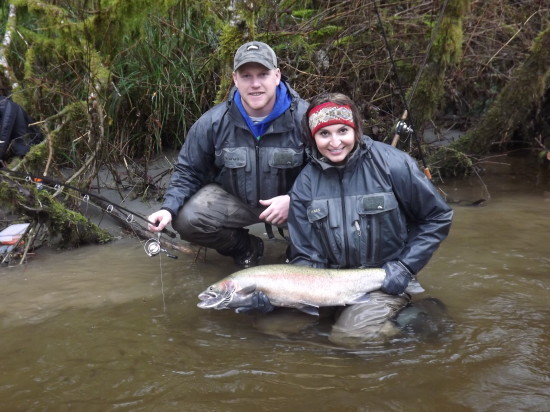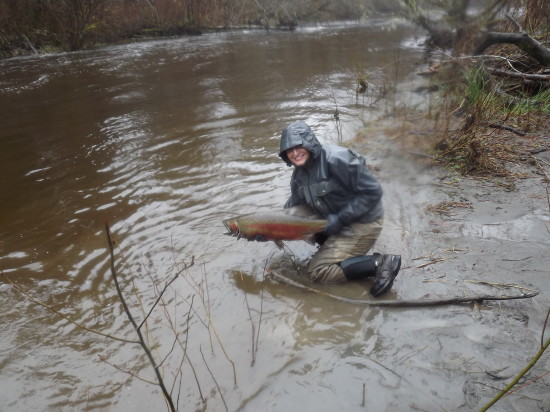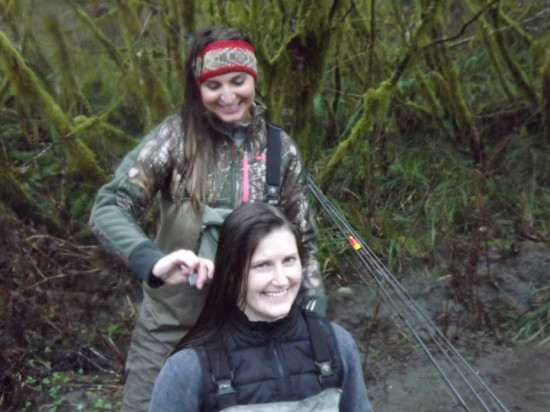Tribal fishing guide Ashley Nichole Lewis proves ‘girlyness and bad-ass angling skills are not mutually exclusive.’
By Jeff Holmes
Last December’s annual Real Women of Northwest Fishing feature motivated me to do a better job in my own writing of shining the spotlight on the growing numbers of women who love to fish and who find joy plying waters across the Northwest, whether it be on an Eastern Washington brook trout lake, an Oregon Coast creek, an Idaho pike and bass lake, or Buoy 10. From occasional weekend anglers, to diehard female fishing guides, to women who tie their own “everything” and love all things fishing, there’s a wide spectrum of female anglers who deserve more attention – and the right kind.
In an age of paid Facebook campaigns featuring cute girls who are not authentic, self-supporting anglers but who are on pro staffs, I’ll try to feature interesting and skilled female anglers exclusively, starting with a young tribal guide on the Quinault Indian Nation’s Salmon River and Cook Creek, Ashley Nichole Lewis. Ashley’s from Elma but lives in Tacoma and is one of the Northwest’s up-and-coming cosmetologists while succumbing to none of the stereotypes. She handles fish, bait, rowdy hole crashers, and the world of beauty with ease.

Combine tribal heritage, fish-catching skills and a 4.0 grade-point average at beauty school and what do you get? Ashley Nichole Lewis, here holding a nice Cook Creek steelhead while friend Darren Hoberg looks on. (JEFF HOLMES)
Some of the Northwest’s earliest returning winter steelhead come back to Cook Creek every year, which is a lower Quinault River tributary. The creek is off-limits to nontribal members unless accompanied by one of many walk-in guides who regularly or occasionally hike clients to both Cook and the Salmon, a tributary of the Queets. Ashley and her manfriend, Darren Hoberg, scored some of the earliest chrome planks of winter steelhead to flash across Facebook in late November. I noticed her posts were authentic and smart and didn’t sell out rivers, and I also noticed that she was a 4.0 cosmetology student at Clover Park Technical College. I began to hatch a slowly evolving plan for a really weird sporting feature. I was going to gain access to Cook Creek, meet some highly recommended anglers and people, and profile a mega-cool female angler.
All while getting my wife, Erika, a streamside haircut.
WE MET ASHLEY and Darren at the Quinault National Fish Hatchery in late January, in a driving coastal mist. A tribal law enforcement officer came down to chat with Ashley just as Erika and I introduced ourselves. He was looking for snaggers. Fortunately we’d left our cannonballs and trebles at home. Seriously, who’s a big enough bozo to snag winter steelhead? Uh, lots of people from all walks of life, although we’d witness no such activity that day.
We donned waders and rain gear, and Erika pulled unidentified white bits out of her wading boot during a gravel check. We thought it was paper, until I smelled it. Deer fat. Mice had penetrated our shop and used Erika’s boot as a cache for perhaps 8 to 10 ounces of fat bits. She wasn’t thrilled since it was technically my fault I’d left boots in the shop and let mice get in there, and for long enough to stash enough calories for a generation of mice. She laughed it off and forged ahead through the hatchery toward a series of several downstream holes and runs.

The trend of big steelhead, like this one caught by Lewis, will continue at Cook Creek. Though the base stock used is a smaller strain, Quinault River winter-runs have contributed their genes, resulting in larger fish returning to the facility, which, due to harmful past logging, produces salmonids for tribal fisheries. (JEFF HOLMES)
The impressive hatchery facility produces coho, chum and steelhead in great abundance and for the sole purpose of providing tribal fishing opportunities. The fish reared here are not clipped, and an electric cable across the stream above the hatchery intake shocks fish back downstream to keep them from moving above the freshwater intake to prevent spread of disease to the hatchery. That cable is reportedly dangerous enough to have electrocuted a bear two years ago. It’s being replaced soon. The Cook Creek facility produces Hoh River steelhead stock, which average 4 to 7 pounds. That stock hasn’t changed in size, but the average size of Cook Creek hatchery steelhead has, thanks to stray influence from the largest genetic stock of hatchery fish in the Northwest: Lake Quinault hatchery broodstock fish regularly top 20 pounds. In recent years, however, due mostly to increased summer water temperatures, pathogen levels in the lake have been too high to raise fish reliably, so those fish are still collected at the lake but now spend a large portion of their early life cycle at Cook Creek. They are trucked back to the lake for release as smolts. Most of those fish are returning to the lake, but good numbers showed up at the hatchery as strays, thanks to their time there before release.
ANOTHER GUIDE HAD clients in Cook Creek’s famed first hole. He and Ashley coolly greeted each other as we filed past. The visibility looked good at 3 feet, but the water was high and just starting to drop. We waded through flooded trails downstream to the next two holes and found the second empty. Fish were stacked in like cordwood in soft water along a bank, and Ashley quickly hooked up, followed by Darren, followed by Erika. When those fish wouldn’t eat my crappy, leathery eggs, I kept fishing them while taking breaks to photograph their fish.
Whereas I expected to see little one-salt steelhead like those that had been in the creek from late November through mid-January, we hooked 30-plus-inchers fish after fish, led by Darren who landed a colored-up buck a hair short of 40 inches, along with several fish over 34. Most of these fish were booting up, but every once in a while a giant chromer would bite us and turn and run downstream. There were several break-offs even with 12-pound Ultragreen. Ashley also hooked a number of brutes, mostly on single beads fished below a float. The rain poured down as we caught and released brutes and occasional small chromers, and lots of cutthroat trout.
On a day filled with laughs and steelhead galore, we finished off our time at the creek with a haircut for Erika and a happy walk back to dryness at our trucks.

Just a little off the back, please! The author’s wife, Erika, enjoys a streamside haircut from Ashley, who has a salon and spa near Tacoma. (JEFF HOLMES)
ASHLEY’S NOT ONLY a skilled angler who can get you access to robust hatchery runs and three-fish limits, she will also cut hair streamside with some serious skills. She’s an award-winning student who regularly volunteers her time for her college, sometimes giving free cosmetology services to elders from the Puyallup Tribe. She has big plans to build her business, but also values giving back to the community and shows genuine appreciation to her tribe for providing a scholarship to make her career dreams possible. Erika not only loved her haircut and the experience, she wants to go back next year and is now planning to drive from Tri-Cities to Tacoma for haircuts. If you’re looking for Cook Creek access with someone who’s dialed in, I’d highly recommend a walk-in trip with her. If you want to become a client of an up-and-coming and highly skilled cosmetologist who can talk everything from elk hunting to Gelish nails while backing it up, she’s a great person to connect with on Facebook, at (360) 915-3667 or at her salon, at (253) 845-9744. Ashley is living evidence that girlyness and bad-ass angling skills are not mutually exclusive. NS

 Edited
Edited